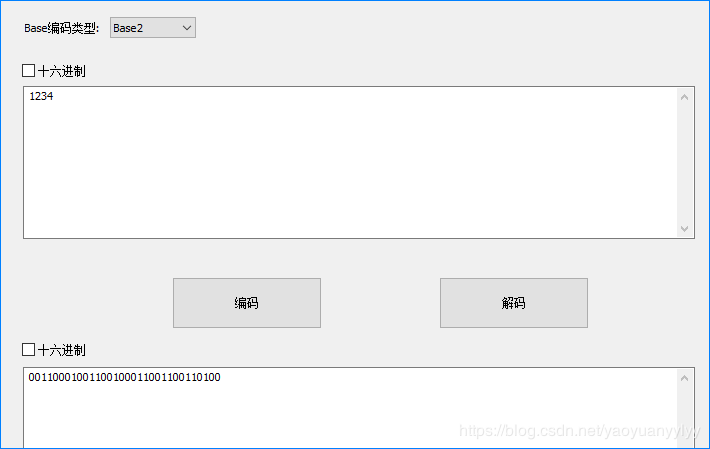基于C++实现的一种通用Base编解码器(Hex(Base16)/Base32/Base64)
使用Hex(十六进制)编码、Base32编码和Base64编码可以将原始数据编码为可视化字符串。它们的原理是一样的,都是将指定位数的原始数据编码为特定字符空间中的一个字符。
- Hex:也叫作Base16编码;每4位编码为一个字符,字符空间为"0123456789abcdef"或"0123456789ABCDEF";不区分大小写,其中的字母可以编码为大写也可以编码为小写,同时解码也不区分大小写,应该能对大小写的HEX字符串都能正确解码;
- Base32:每5位编码为一个字符,字符空间为"ABCDEFGHIJKLMNOPQRSTUVWXYZ234567",大小写敏感;
- Base64:每6位编码为一个字符,字符空间为"ABCDEFGHIJKLMNOPQRSTUVWXYZabcdefghijklmnopqrstuvwxyz0123456789+/",大小写敏感;
填充: 对于Base32和Base64,如果待编码的数据的比特数不是5或6的倍数,则需要进行填充,标准的填充字符为’=’。
本文使用C++实现一种通用的Base编解码器,类名命名为BaseCodec。完整代码贴在文章末尾。
首先,提炼并定义Base编码的影响因素:
char mPaddingChar;
bool mIgnoreCase;
int mPartialBits;
std::string mBase;
其含义为:
- mPaddingChar: 填充字符
- mIgnoreCase:是否忽略大小写
- mPartialBits:分割位数,即多少位编码为一个字符
- mBase:字符空间
这四个参数通过BaseCodec的构造函数传入并赋值:
BaseCodec::BaseCodec(const std::string& pBase, char paddingChar, int partialBits, bool ignoreCase)
{
mBase = pBase;
mPaddingChar = paddingChar;
mPartialBits = partialBits;
mIgnoreCase = ignoreCase;
}
有了这四个参数,就可以开始编解码了。
然后,定义类的3个public接口,包括编码、解码以及字符格式检测。
public:
/**
* Encoder
*/
std::string Encode(const std::string& input);
/**
* Decoder.
*
* throw std::exception if input length error or has invalid character.
*/
std::string Decode(const std::string& input);
/**
* Format check.
*
* A valid character will be in pBase pass into constructor , case-insensitive.
*/
bool Check(const std::string& data);
接着,通过上面的构造函数和3个公共接口,就可以定义我们需要编解码器了。这里定义了以下的几个:
public:
/** Binary Codec*/
static BaseCodec Binary;
/** Hex Codec(lowercase)*/
static BaseCodec Hex;
/** Hex Codec(uppercase)*/
static BaseCodec Hexu;
/** Base32 Codec*/
static BaseCodec Base32;
/** Base64 Codec*/
static BaseCodec Base64;
把各个编解码器声明为BaseCodec的public静态变量,以便于引用。它们的定义为;
static const char CHAR_BASE_2[] = "01";
static const char CHAR_BASE_16[] = "0123456789abcdef";
static const char CHAR_BASE_16u[] = "0123456789ABCDEF";
static const char CHAR_BASE_32[] = "ABCDEFGHIJKLMNOPQRSTUVWXYZ234567";
static const char CHAR_BASE_64[] = "ABCDEFGHIJKLMNOPQRSTUVWXYZabcdefghijklmnopqrstuvwxyz0123456789+/";
static const char CHAR_PADDING = '=';
BaseCodec BaseCodec::Binary(CHAR_BASE_2, CHAR_PADDING, 1, false);
BaseCodec BaseCodec::Hex(CHAR_BASE_16, CHAR_PADDING, 4, true);
BaseCodec BaseCodec::Hexu(CHAR_BASE_16u, CHAR_PADDING, 4, true);
BaseCodec BaseCodec::Base32(CHAR_BASE_32, CHAR_PADDING, 5, false);
BaseCodec BaseCodec::Base64(CHAR_BASE_64, CHAR_PADDING, 6, false);
这样,便可以通过如下的形式:
- BaseCodec::Base64.Encode
- BaseCodec::Base64.Decode
- BaseCodec::Base64.Check
进行引用了。
在上面定义的编解码器中的BaseCodec::Hex和BaseCodec::Hexu是十六进制编解码器,前者是编码为小写字母,后者是编码为大写字母;当然,两者都应该能够同时解码大小写字母,因为它们已经声明为忽略大小写的。
BaseCodec::Binary是一个二进制编码器。如对“1234”进行二进制编码:

有了上面的编解码器示例,可以很容易地定义出类似的其他的编解码器,或者更改字符空间也可以定义出私有的编解码器。
比如,我们可以定义一个Base8编码器,即每3位编码为一个字符,字符空间为"01234567"。
static const char CHAR_BASE_8[] = "01234567";
BaseCodec Octal(CHAR_BASE_8, CHAR_PADDING, 3, false);
编解码:当然最重要的还是编码和解码函数的实现。编解码函数的参数采用C格式,这样可以方便在需要时转为C代码。上面的公共接口使用C++和std::string封装了一下。编解码函数如下:
int BaseCodec::Encode(const unsigned char *input, char *output, int length)
{
if (length <= 0 || input == nullptr)
return 0;
int partialBits = mPartialBits; //编码为1个字节的位数
const char* pBase = mBase.c_str(); //编码字符空间
int nlcm = lcm(8, partialBits); //编码位数和8的最小公倍数
int nn = length * 8 / nlcm; //非剩余编码的块数
int retLength = nn * (nlcm / partialBits); //编码后的长度: 首先是非剩余编码的长度
int padCount = 0; //填充长度
//有剩余位时则有填充
nn = length * 8 % nlcm; //剩余位数
if (nn != 0) {
padCount = (nlcm - nn) / partialBits; //填充长度
retLength += nlcm / partialBits; //编码后的长度: 然后是剩余+填充的长度
}
if (output == nullptr) return retLength; //返回长度
unsigned char current; //中间缓存变量
unsigned char mask = (1 << partialBits) - 1; // 编码转换掩码
int codedOffset = 0; //已编码的长度偏移
int leftBits = 0; // 剩余的未编码数据的位数
unsigned char left_temp; // 剩余的未编码的数据
for (int i = 0; i < length; i++)
{
int currentBits; //当前未处理的比特数
if (leftBits == 0) {
currentBits = 8;
} else {
currentBits = 8 + leftBits - partialBits; //先处理一次之后剩余的比特数
unsigned char mask_need = (1 << (partialBits - leftBits)) - 1; //编码上次剩余的数据还差的位数掩码
mask_need <<= currentBits; //左移以便取高位
//处理上次剩余的数据
current = (left_temp << (partialBits - leftBits)) | ((input[i] & mask_need) >> currentBits);
current &= mask;
output[codedOffset++] = pBase[(int)current];
}
int times = currentBits / partialBits; //当前剩余的数据可以转换编码的次数
unsigned char mask_can_be_coded = (1 << (partialBits*times)) - 1; //当前可编码的数据掩码
mask_can_be_coded <<= (currentBits - partialBits * times);
unsigned char temp_to_coded = (input[i] & mask_can_be_coded); //当前剩余可编码数据
leftBits = currentBits - partialBits * times;
unsigned char mask_temp_left = (1 << (currentBits - partialBits * times)) - 1; //本次未编码的数据掩码
left_temp = (input[i] & mask_temp_left);
//将本次可编码的数据进行编码
for (int m = 0; m < times; m++) {
current = temp_to_coded >> (currentBits - (m + 1) * partialBits);
current &= mask;
output[codedOffset++] = pBase[(int)current];
}
}
//剩余位
if (leftBits != 0) {
current = (left_temp << (partialBits - leftBits));
current &= mask;
output[codedOffset++] = pBase[(int)current];
}
//填充
//padCount = retLength - j;
for (int i = 0; i < padCount; i++)
output[codedOffset++] = mPaddingChar;
output[codedOffset] = '\0';
return retLength;
}
int BaseCodec::Decode(const char *input, unsigned char *output)
{
int length = strlen(input);
if (input == nullptr || length == 0)
return 0;
int partialBits = mPartialBits; //编码为1个字节的位数
const char* pBase = mBase.c_str(); //转换字符空间
int nlcm = lcm(8, partialBits); //编码位数和8的最小公倍数
if ((length % (nlcm / partialBits)) != 0)
throw std::exception("input length error");
int padCount = 0; //填充长度
for (int i = length - 1; i > length - nlcm / partialBits; i--) {
if (input[i] == mPaddingChar)
padCount++;
else
break;
}
int retLength; //解码后的长度
int leftPadChar = 0; //最后一个完整块中的非填充字节数
if (padCount != 0) {
leftPadChar = nlcm / partialBits - padCount;
retLength = (length - nlcm / partialBits)*partialBits/8; //首先是非剩余编码的长度
retLength += (leftPadChar - 1);
} else {
retLength = length * partialBits / 8;
}
if (output == nullptr) return retLength; //返回长度
unsigned char mask = (1 << partialBits) - 1; // 编码转换掩码
int codedOffset = 0; //已编码的长度偏移
int leftBits = 0; // 剩余的未解码数据的位数
unsigned char left_temp; // 剩余的未解码的数据
int index = 0;
for (int i = 0; i < (length - padCount); i++)
{
index = GetCharPos(pBase, input[i], mIgnoreCase);
if (index == -1)
throw std::exception("has invalid char");
unsigned char temp = index & mask;
if (leftBits != 0)
{
leftBits += partialBits;
if (leftBits >= 8)
{
leftBits -= 8;
output[codedOffset++] = (left_temp << (partialBits - leftBits)) | (temp >> leftBits);
unsigned char mask_left = (1 << leftBits) - 1;
left_temp = temp & mask_left;
} else {
left_temp = (left_temp << partialBits) | temp;
}
} else {
leftBits = partialBits;
left_temp = temp;
}
}
output[codedOffset] = '\0';
return retLength;
}
在编解码中,有两点是重要的:一是编解码后的长度和填充字符的长度计算;二是在连续处理字符时,要在处理当前字节数据的同时,处理掉上次剩余的数据。
在编码解码函数中,还用到了两个辅助函数,一个是最小公倍数的计算,另一个是在字符串中查找字符位置。
还需要考虑的问题:端序与异常。本例是在Windows的VS中编写的,std::exception异常有默认的可传入消息的构造函数;端序也没有考虑。在其他的平台上可能需要考虑这两个问题。